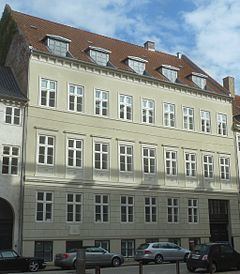Completed 1703 Opened 1703 | Client Abraham Lehn | |
 | ||
Owner Andelsforeningen Tordenskjolds Gård Architectural styles Baroque architecture, Neoclassical architecture Similar Strandgade 24, Steinfass House, Heering House, Christian IV's Arsenal, Søkvæsthuset | ||
The Lehn House (Danish: Lehns Gård) is a historic townhouse on Strandgade in the Christianshavn neighbourhood of central Copenhagen, Denmark. It is also known as the Tordenskjold House (Danish: Tordenskjolds Gård) after Peter Jansen Wessel Tordenskiold commonly referred to as Tordenskjold, who for a while lived in the building. The Danish Authors' Society is now based in the property whose meeting facilities are also rented out for events. The rooms are notable for their lavish stucco ceilings and murals.
Contents
History
The first house at the site was probably built shortly after Christianshavn was established on reclaimed land in 1617-22. Abraham Lehn replaced it with a new house in 1703. He was a wealthy merchant, shipowner and director of Danish East Asia Company.
When Abraham Lehn died in 1709, his son Abraham Lehn Jr. rented it ot. Tordenskjold, a friend of his, had his first home on land since his childhood in the building from 1718 until his death in 1720. Lehn Jr. made the house his family home in 1721 but sold it in 1732 to Christian Ditlev Reventlow, whose son, Christian Ditlev Frederik Reventlow, a key figure in the Danish agriculatural reforms of the 1770s, was born in there in 1748. From 1755, the building served as headquarters for the Danish West India Company. In 1762, the property was purchased by Peter Fenger, another wealthy merchant, who established in soap manufactury in the yard in 1770. In about 1850, the house was purchased by Peter F Heering, who already owned the Heering House close by and had acquired the quay in front of the building from Lehn in 1725.
In 1983, the Danish Authors' Society rented the ground floor of the main wing. In 1993, they acquired their premises as well as part of the basement.
Architecture
The original Baroque-style house was only two storeys high but it was extended to three storeys and adapted in the Late Neoclassical style in 1857-58. The half-timbered side wing was originally only one storey high but later extended with an extra floor.
The Danish Authors' Society's premises in the ground floor are decorated with murals from 1705 by Hendrik Krock featuring subjects from the Old Testament and mythology. The stucco ceilings also date from this time.
In the courtyard to the rear of the building is a small pavilion known as Tordenskjold's Pavilion. It dates from 1763.
